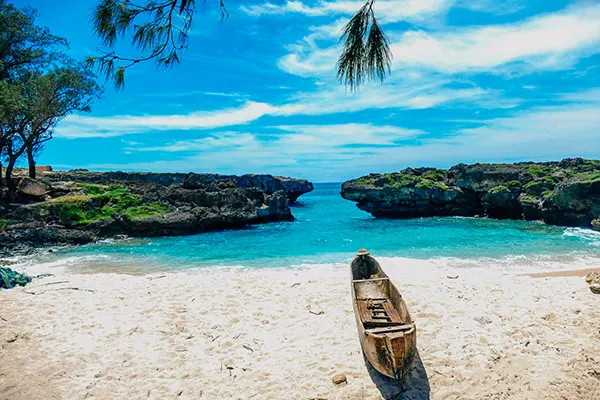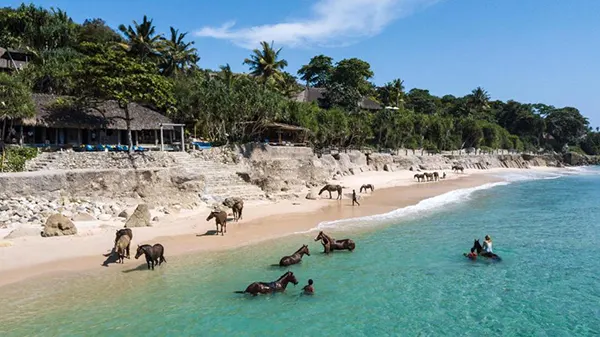
Sumba Island — Indonesia’s New Gem: Wild Beaches, Waterfalls, and Cream Ponies
Sumba Island, located in the eastern part of Indonesia, is emerging as a new gem among the Indonesian archipelago. Known for its wild beaches, cascading waterfalls, and the unique cream-coloured Sumbanese ponies, this island is captivating travellers seeking an authentic, untouched paradise. In this article, we will explore the most remarkable attractions and experiences that make Sumba a must-visit destination in 2025.
Wild Beaches of Sumba Island
Sumba Island is renowned for its unspoiled beaches that stretch along the coast, offering a raw and untouched beauty rarely found in more commercialised destinations. One of the most iconic beaches is Nihiwatu, famous for its powerful surf breaks and golden sands. Travellers flock here to enjoy the world-class waves, while others prefer the quieter stretches where nature reigns supreme.
Another must-visit is Walakiri Beach, distinguished by its picturesque mangrove trees that create a surreal silhouette during sunset. The shallow waters make it ideal for wading and capturing stunning photographs. For those seeking more solitude, Marosi Beach provides a tranquil escape, framed by rugged cliffs and azure waters.
Whether surfing, sunbathing, or simply wandering along the shore, Sumba’s beaches promise an unparalleled connection with nature, far removed from the hustle of urban life.
The Unique Culture Surrounding the Beaches
Besides their natural beauty, Sumba’s beaches are also a hub for local culture and traditions. Villagers often perform rituals by the coast, paying homage to their ancestors and the spirits believed to reside in the sea. These ceremonies offer a glimpse into the island’s rich cultural heritage, making a beach visit not just a scenic experience but a cultural immersion.
The traditional Sumbanese houses, built on stilts with towering thatched roofs, are often visible near coastal areas. These structures reflect the island’s ancient architectural practices and are a testament to the enduring traditions of the Sumbanese people.
Engaging with the local communities enhances the beach experience, allowing visitors to appreciate the deep connection between the islanders and their environment.
The Waterfalls of Sumba — Natural Marvels
Sumba’s waterfalls are as captivating as its beaches, offering refreshing escapes into nature. One of the most renowned is Tanggedu Waterfall, located in East Sumba. Known as the “Grand Canyon of Sumba,” this waterfall features turquoise pools framed by rugged rock formations, creating a dramatic landscape that leaves visitors in awe.
Lapopu Waterfall, situated in West Sumba, is the tallest on the island. Cascading through lush forests, it forms multi-tiered streams that are ideal for swimming. The surrounding flora and fauna add to the waterfall’s enchanting atmosphere, making it a perfect spot for nature lovers.
Kampung Praijing also hosts a smaller, less crowded waterfall, perfect for those looking to escape the more touristy spots. Its serene environment and clear waters make it a hidden gem worth visiting.
Hiking Trails Leading to Waterfalls
Reaching these waterfalls often involves a trek through rugged terrain, offering adventurers a chance to explore Sumba’s wild landscapes. The trails are adorned with exotic plants and the occasional glimpse of Sumbanese wildlife, including birds endemic to the island.
Guided hikes are available for those unfamiliar with the terrain, and local guides share fascinating stories of the land, adding depth to the journey. These trails also pass through traditional villages, giving hikers a chance to observe rural life up close.
Combining waterfall exploration with hiking offers a holistic way to experience Sumba, blending physical activity with cultural discovery.

The Iconic Sumbanese Ponies
One of Sumba’s most unique attractions is its indigenous cream-coloured ponies, known for their endurance and beauty. These ponies play an integral role in local life, used for transport, ceremonial rituals, and traditional horse racing events.
The Pasola Festival, held annually, showcases the Sumbanese ponies in a series of spear-throwing competitions while riding. This centuries-old tradition symbolises courage and unity among the islanders, drawing visitors from around the world to witness this vibrant cultural display.
Horseback riding tours are popular among tourists, allowing them to explore the island’s landscapes from a unique perspective. Whether traversing beaches or mountainous paths, riding a Sumbanese pony offers an immersive connection with the island’s heritage.
Conservation Efforts for Sumbanese Ponies
Despite their cultural significance, these ponies face challenges due to habitat loss and modernisation. Local communities, with the support of conservationists, are making efforts to preserve the breed by maintaining traditional breeding practices and creating protected grazing areas.
Educational programmes aimed at the younger generation are also helping to instil a sense of pride and responsibility in preserving these iconic animals. Such initiatives are vital for ensuring that the Sumbanese ponies remain a living symbol of the island’s heritage.
By participating in conservation activities, visitors can contribute to the preservation of these majestic ponies, fostering a sustainable relationship between tourism and local traditions.
